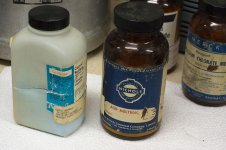I do quite a lot of chemical process like electroforming, chemical etching and polishing, electroplating in wide range of metals, vapour deposition and so on. In fact I do have a small chemistry lab next to the shop where I do the work and store the chemicals - more than 200 bottles and jars of various sizes containing liquids and solids. Many of those chemicals are used only infrequently, for example iridium plating materials. In the past just about all the chemicals were sold in glass containers (sometimes coated on the outside in plastic to prevent breakage) but the trend in the last decades is for plastic containers, mostly polyethylene. In fact one hardy sees glass at all.
When recently looking for Copper Sulfate I have noticed that container is brittle and cracked. Investigating other plastic containers I found six cracked and some materials leaking. Needless to say all the glass is fine. The fact is that plastic will deteriorate and the sale of volatile liquids in plastic is almost criminal because of the permeability of plastics. We are so used to accept the fact that adhesives will harden and other materials evaporate, that nobody complains about it. In the past solvents were sold in metal containers but now this is not the case either. I do usually transfer those to glass or metal and will have to do it now with the rest of my chemicals.
If you have long term storage materials in plastic containers in the shop I suggest transferring those to metal or glass. Scooping a few pounds of spilled potassium cyanide powder is no fun...

When recently looking for Copper Sulfate I have noticed that container is brittle and cracked. Investigating other plastic containers I found six cracked and some materials leaking. Needless to say all the glass is fine. The fact is that plastic will deteriorate and the sale of volatile liquids in plastic is almost criminal because of the permeability of plastics. We are so used to accept the fact that adhesives will harden and other materials evaporate, that nobody complains about it. In the past solvents were sold in metal containers but now this is not the case either. I do usually transfer those to glass or metal and will have to do it now with the rest of my chemicals.
If you have long term storage materials in plastic containers in the shop I suggest transferring those to metal or glass. Scooping a few pounds of spilled potassium cyanide powder is no fun...



